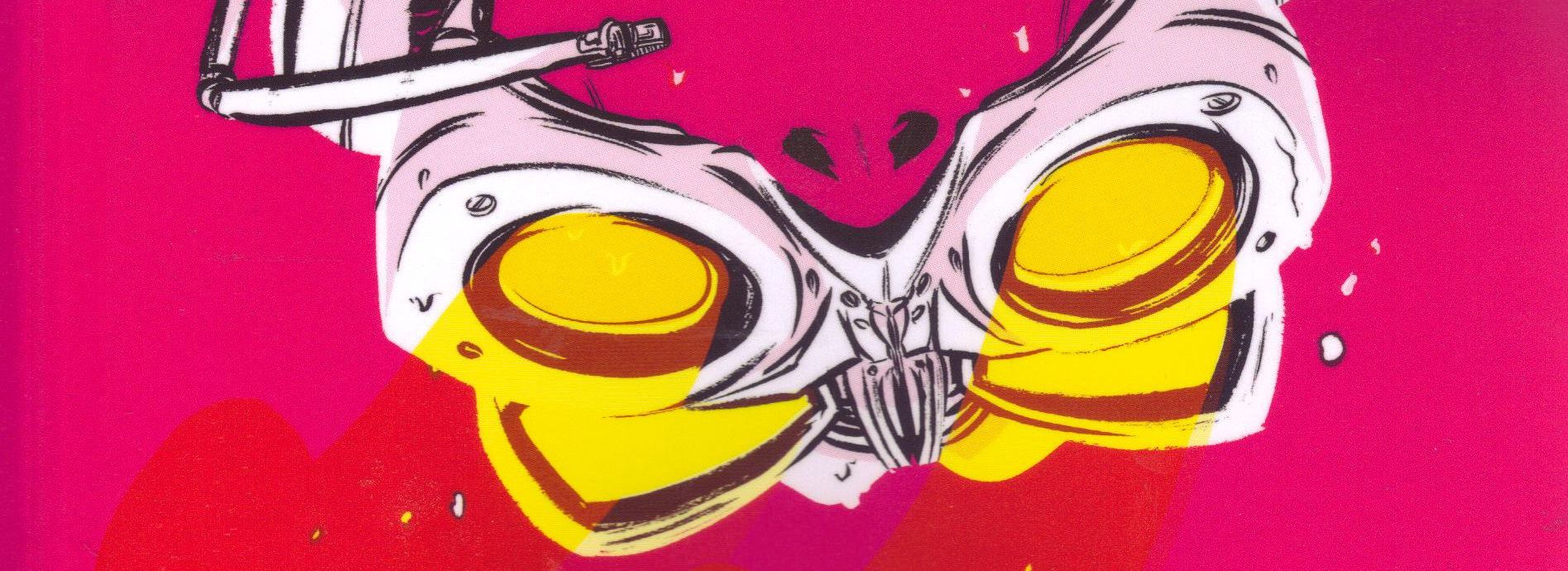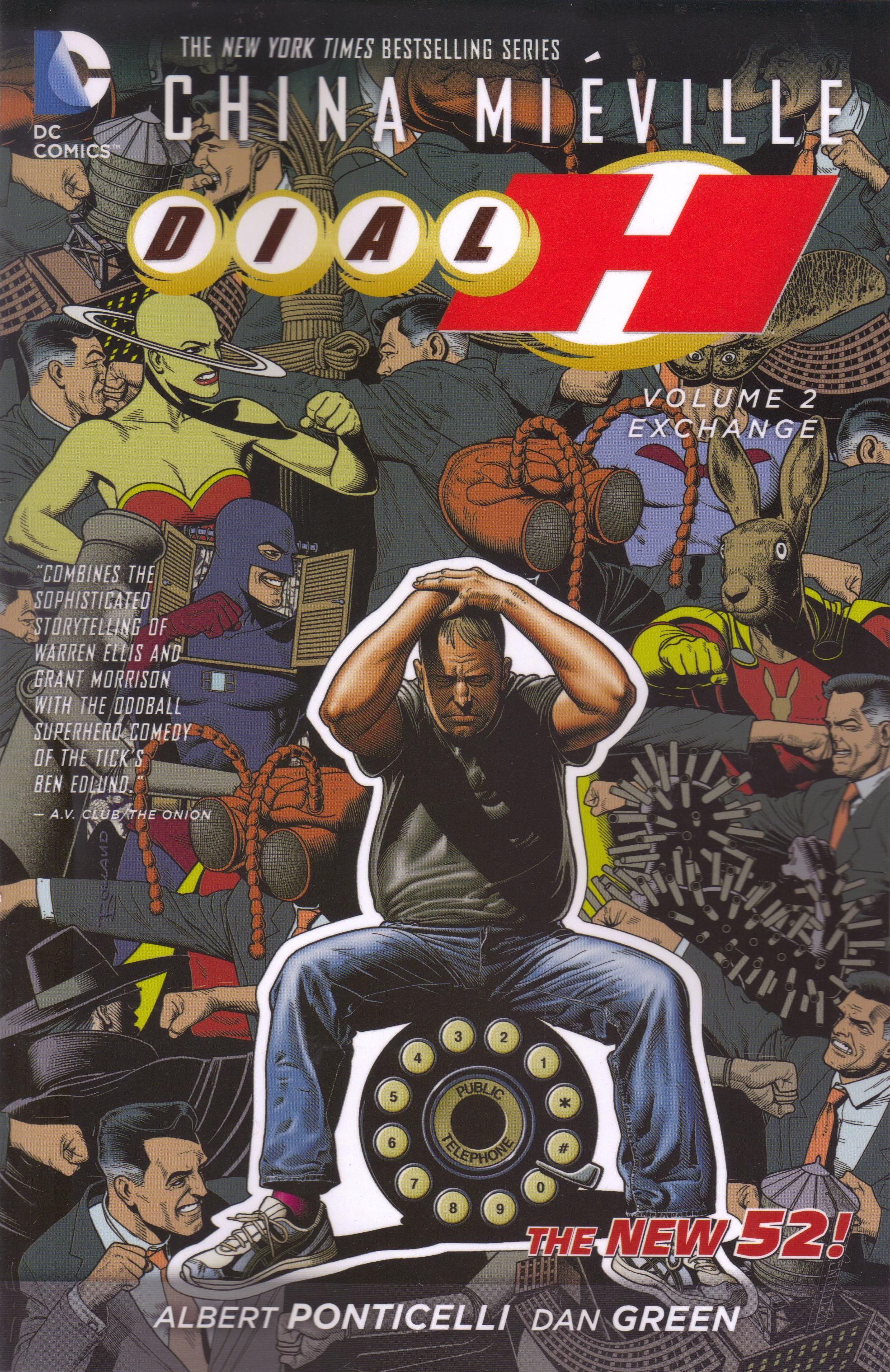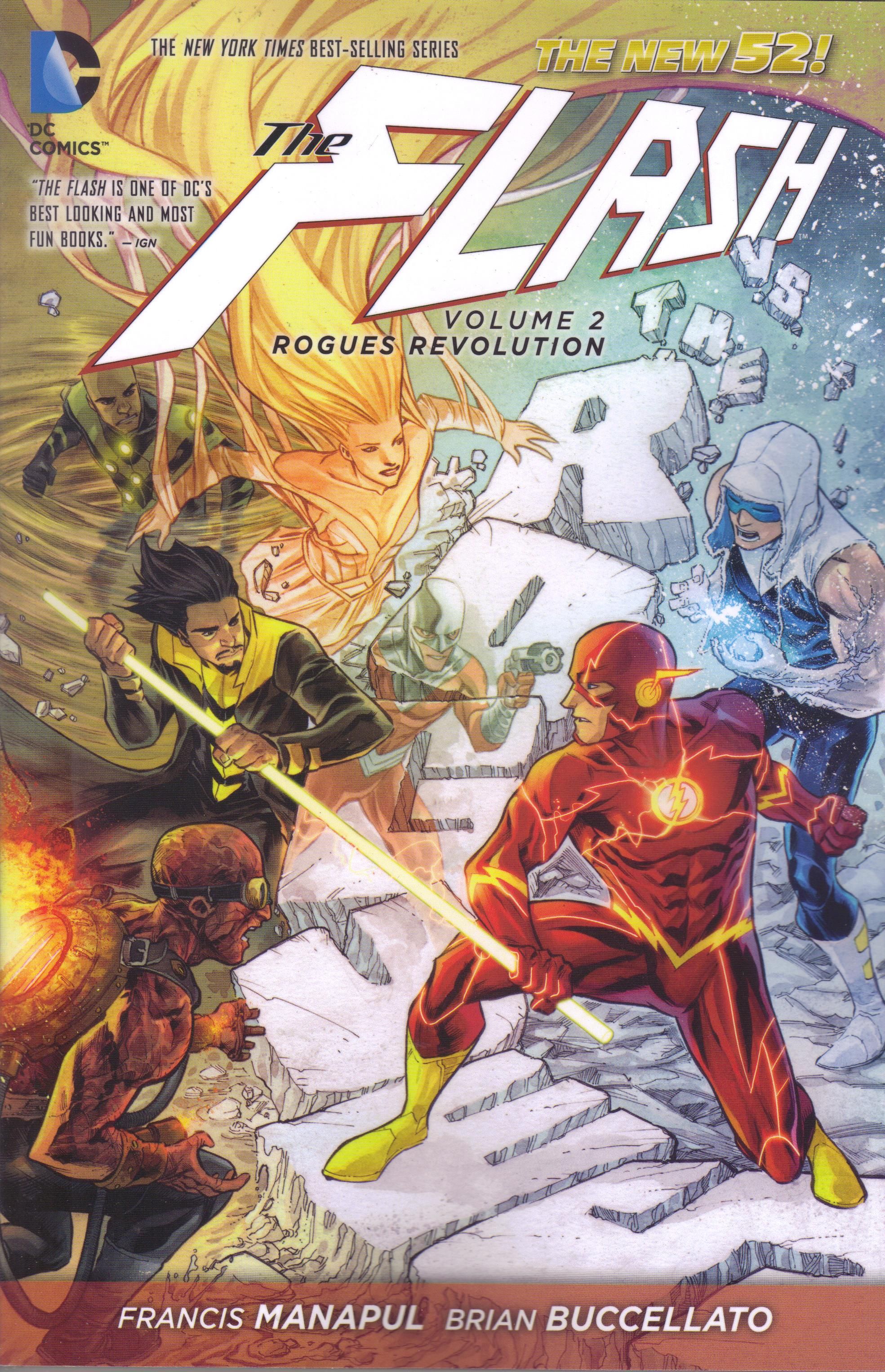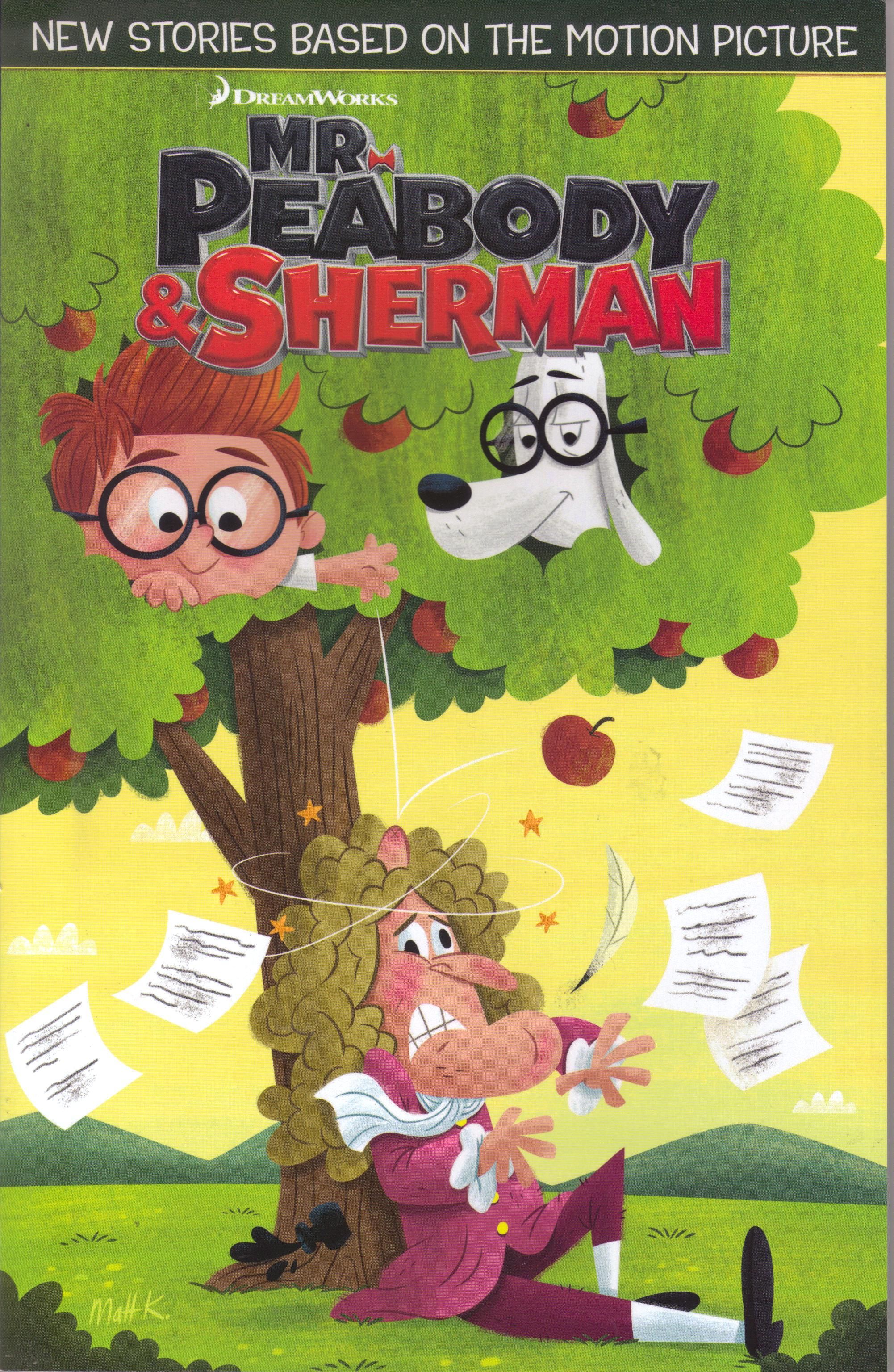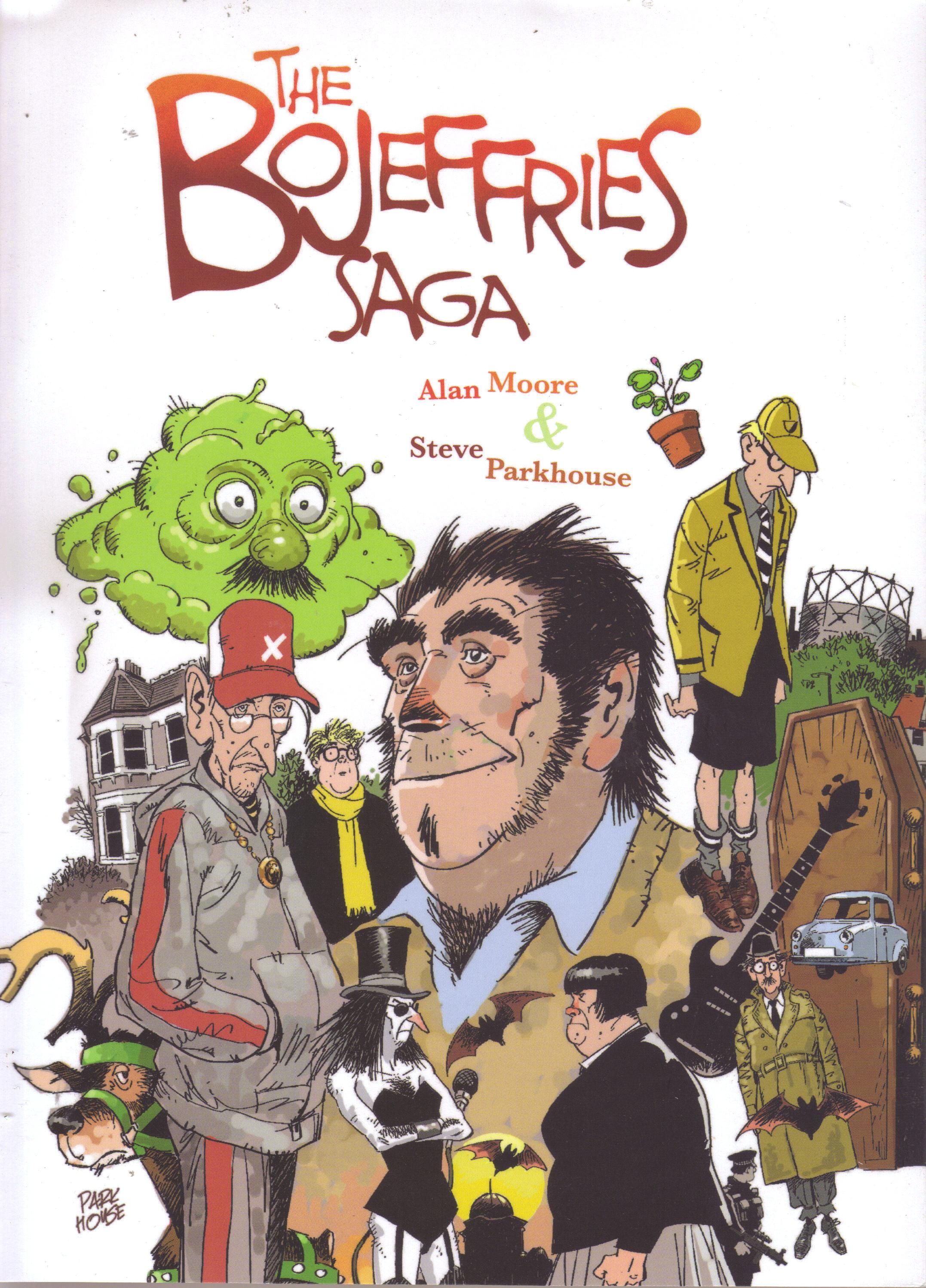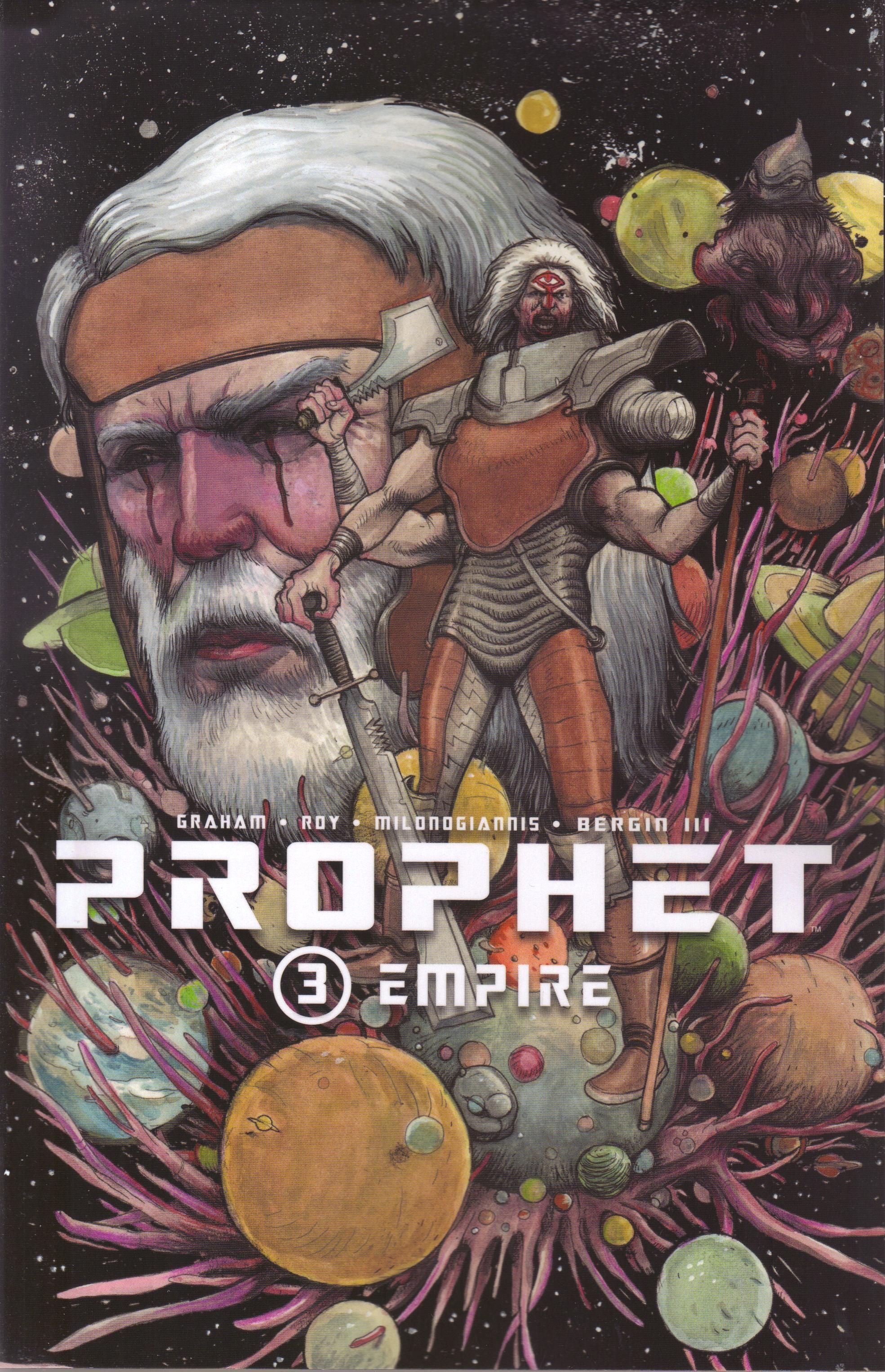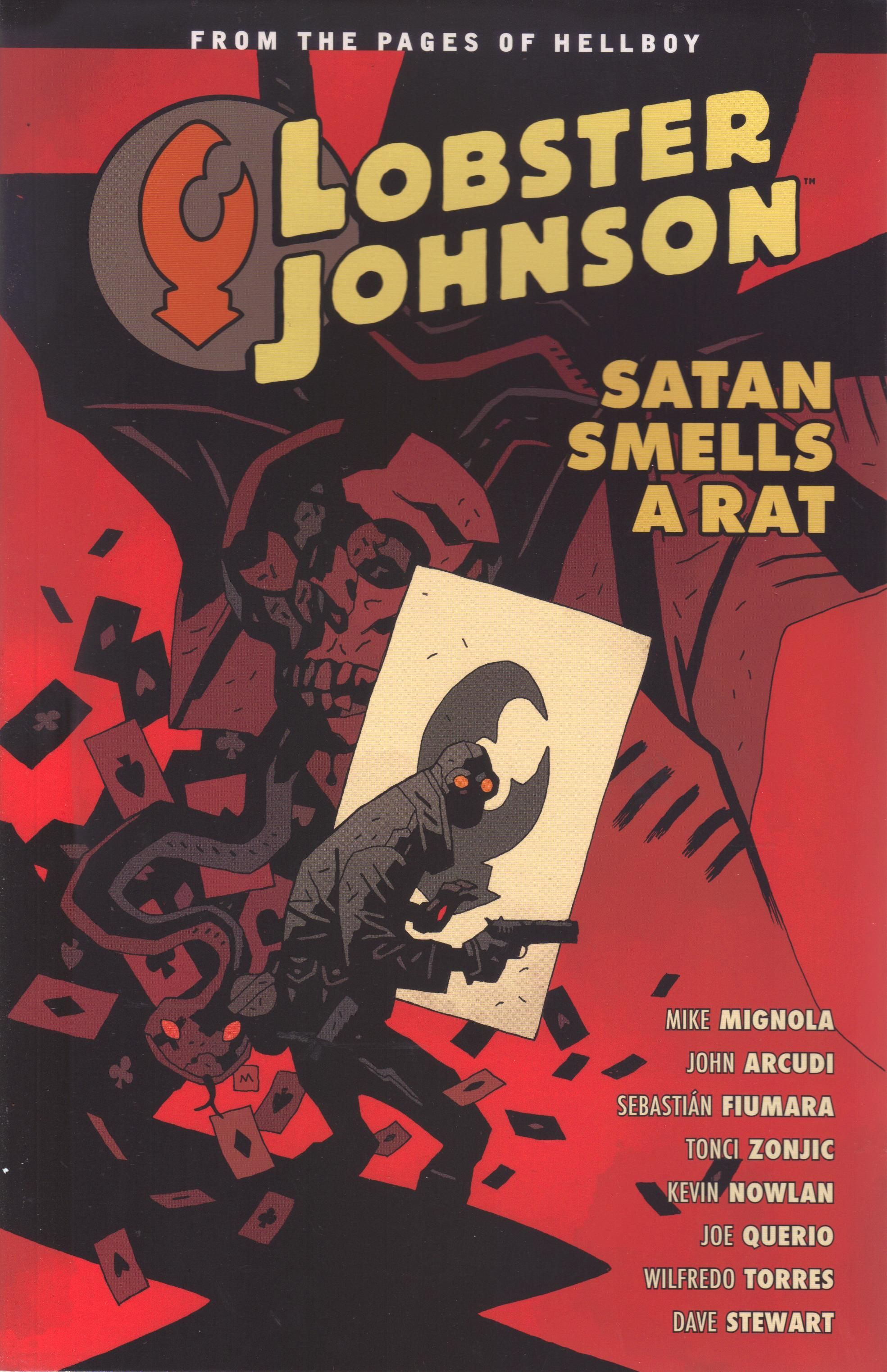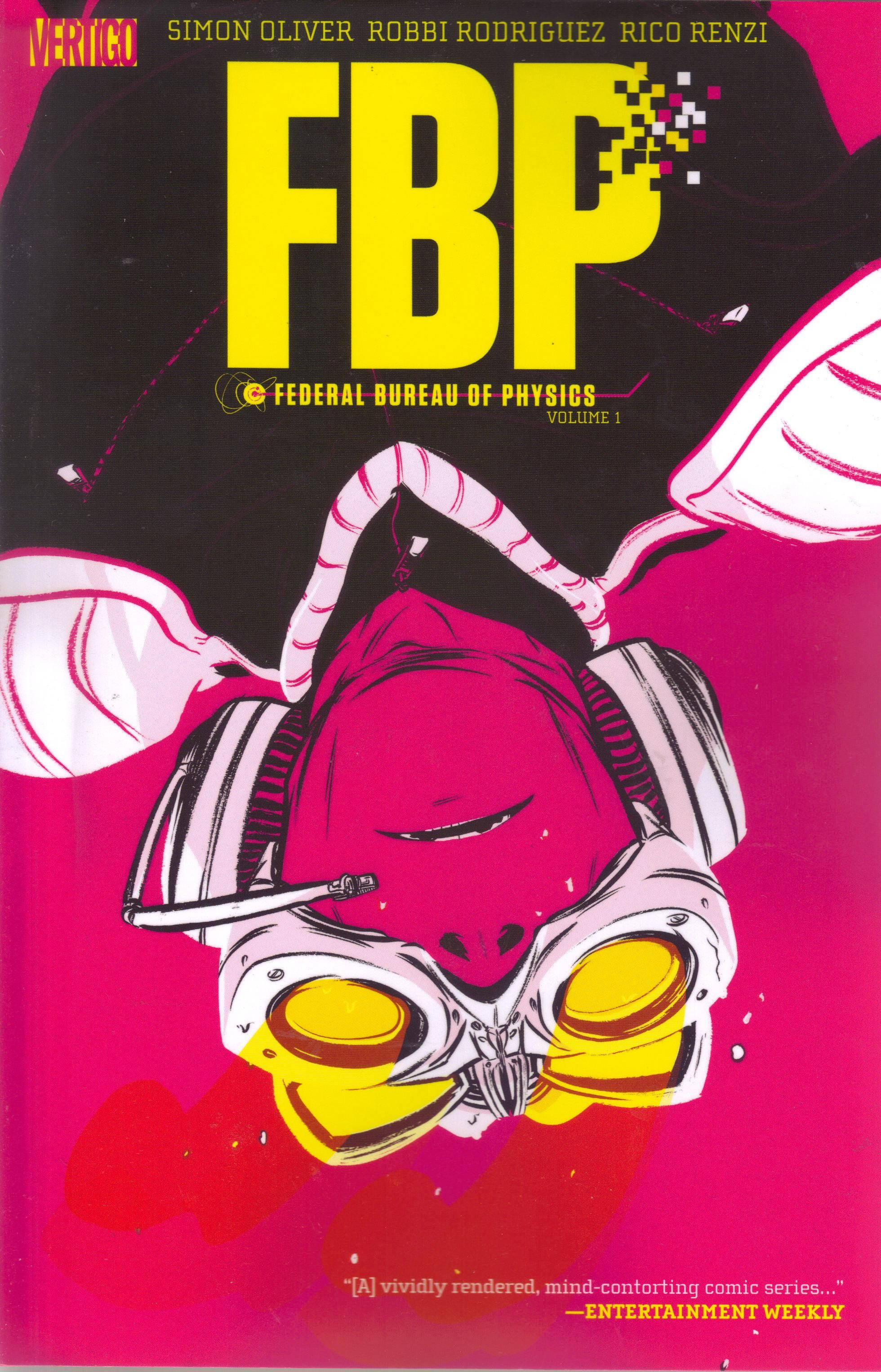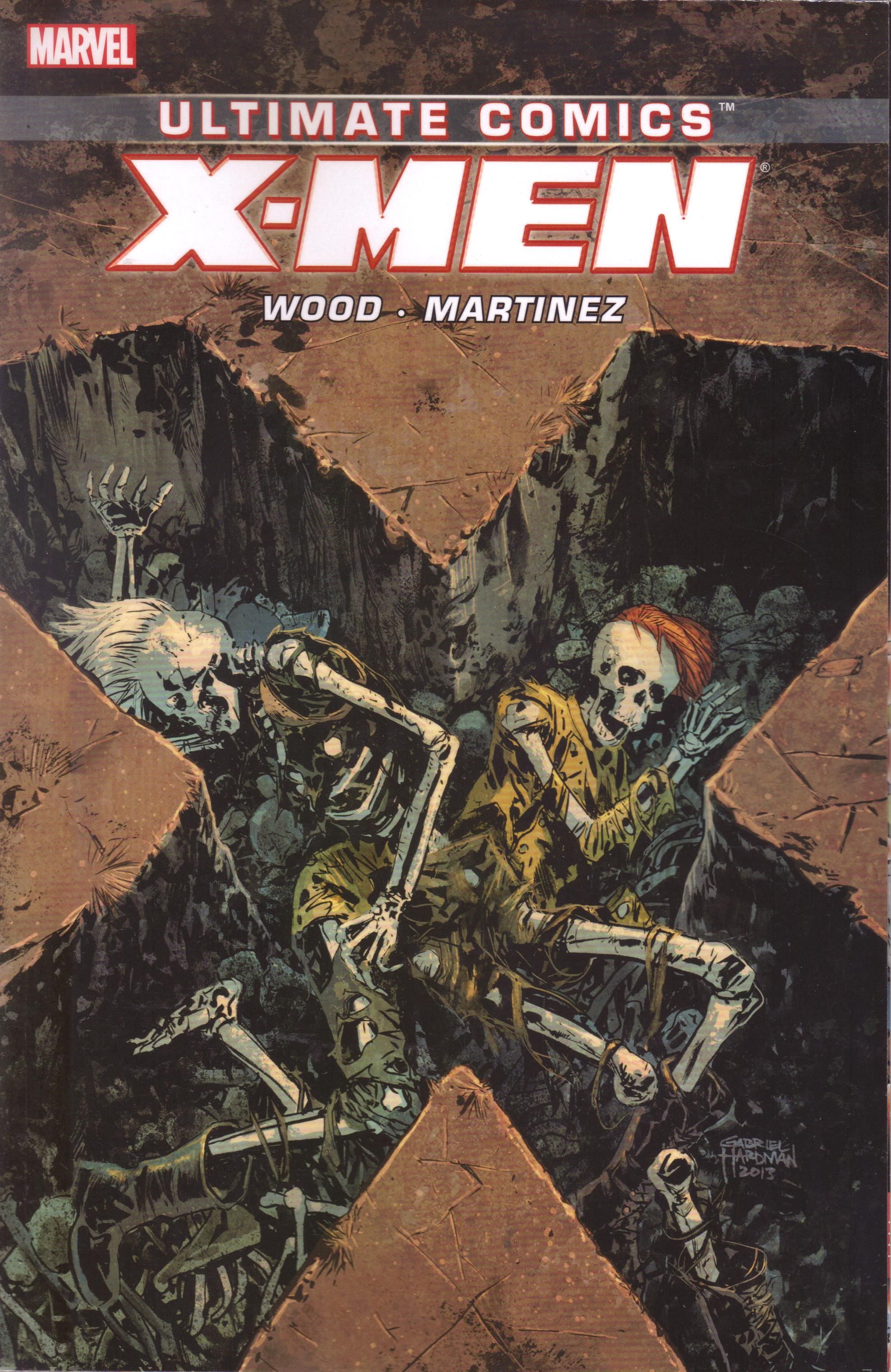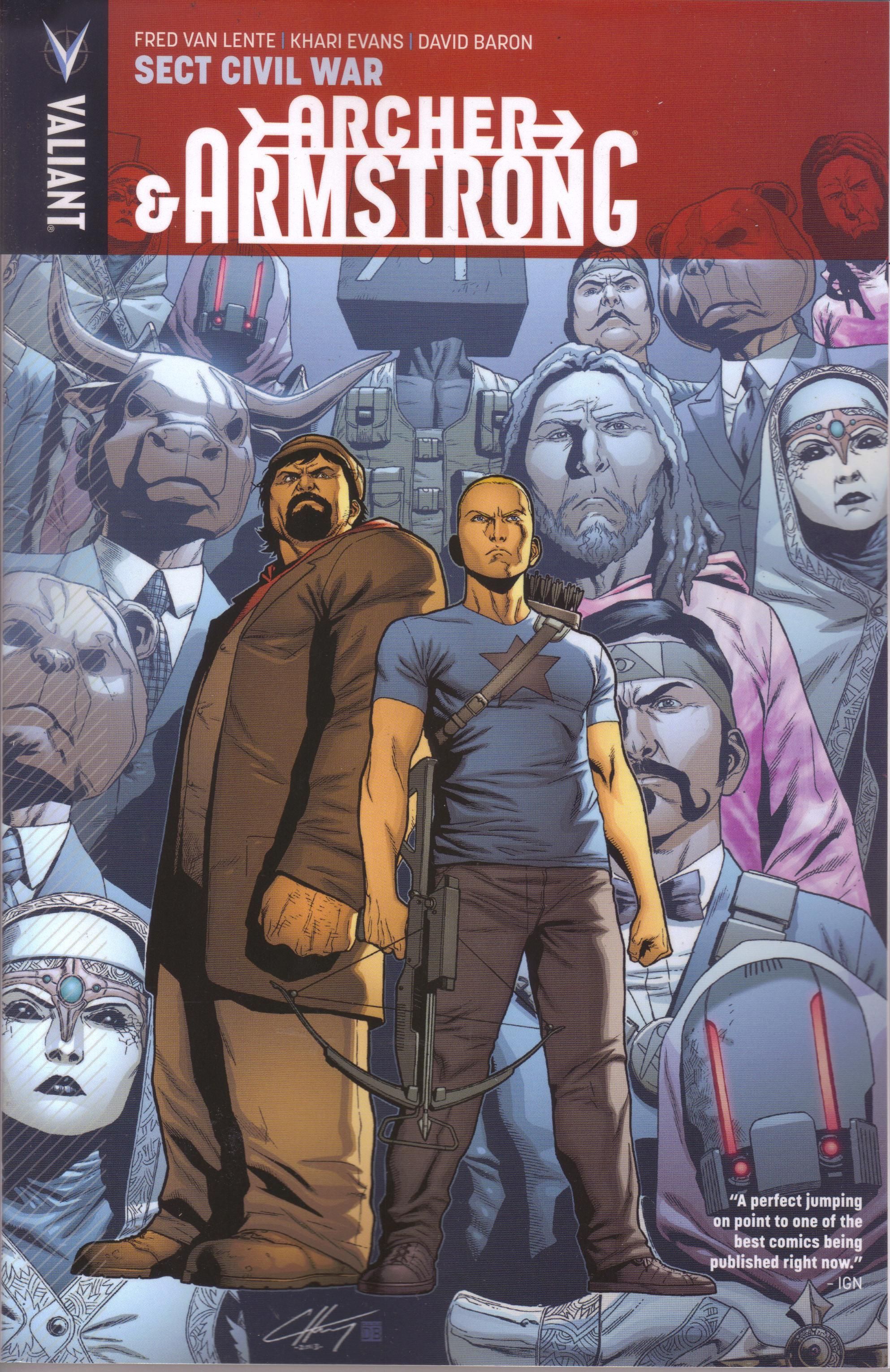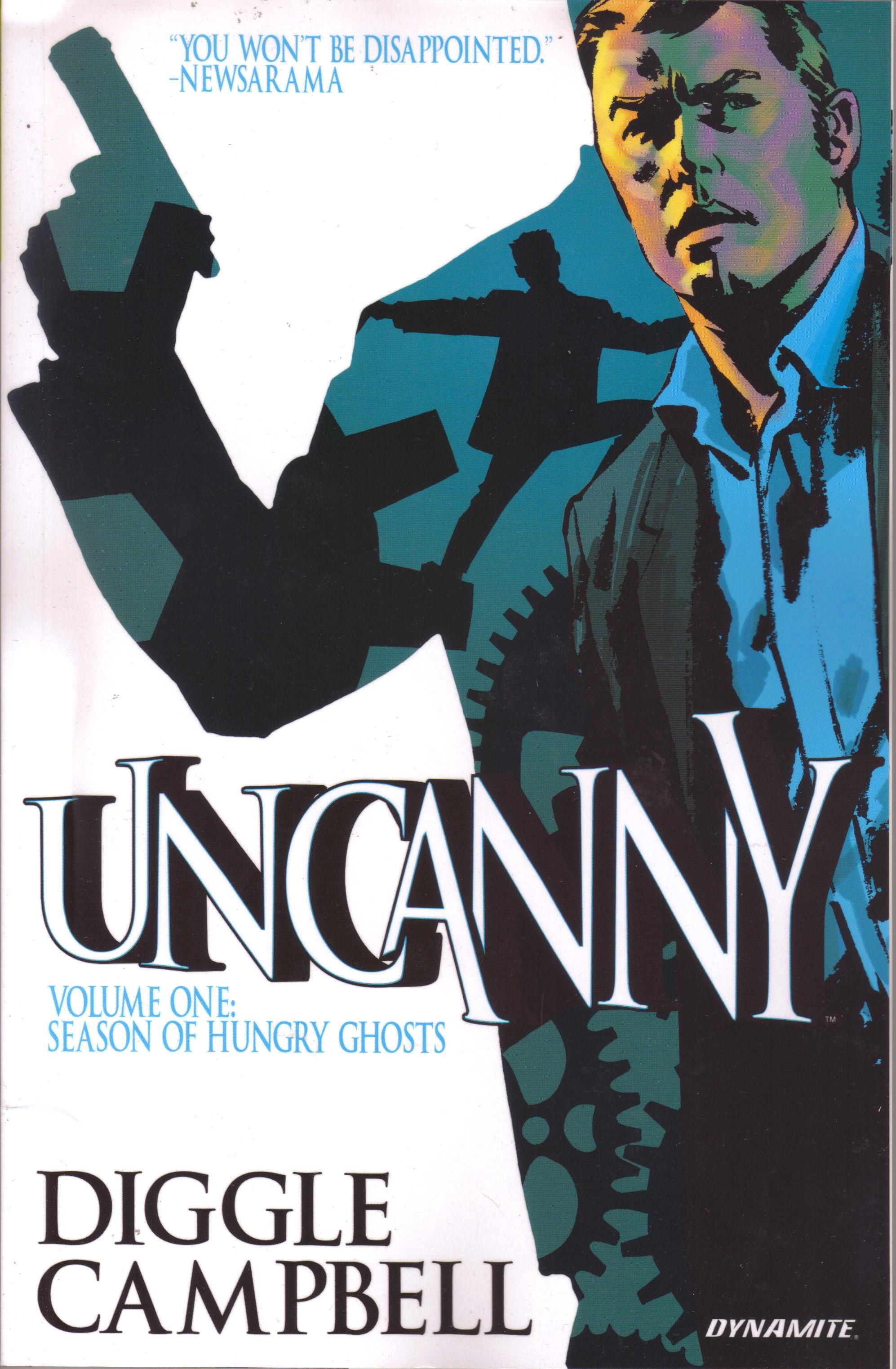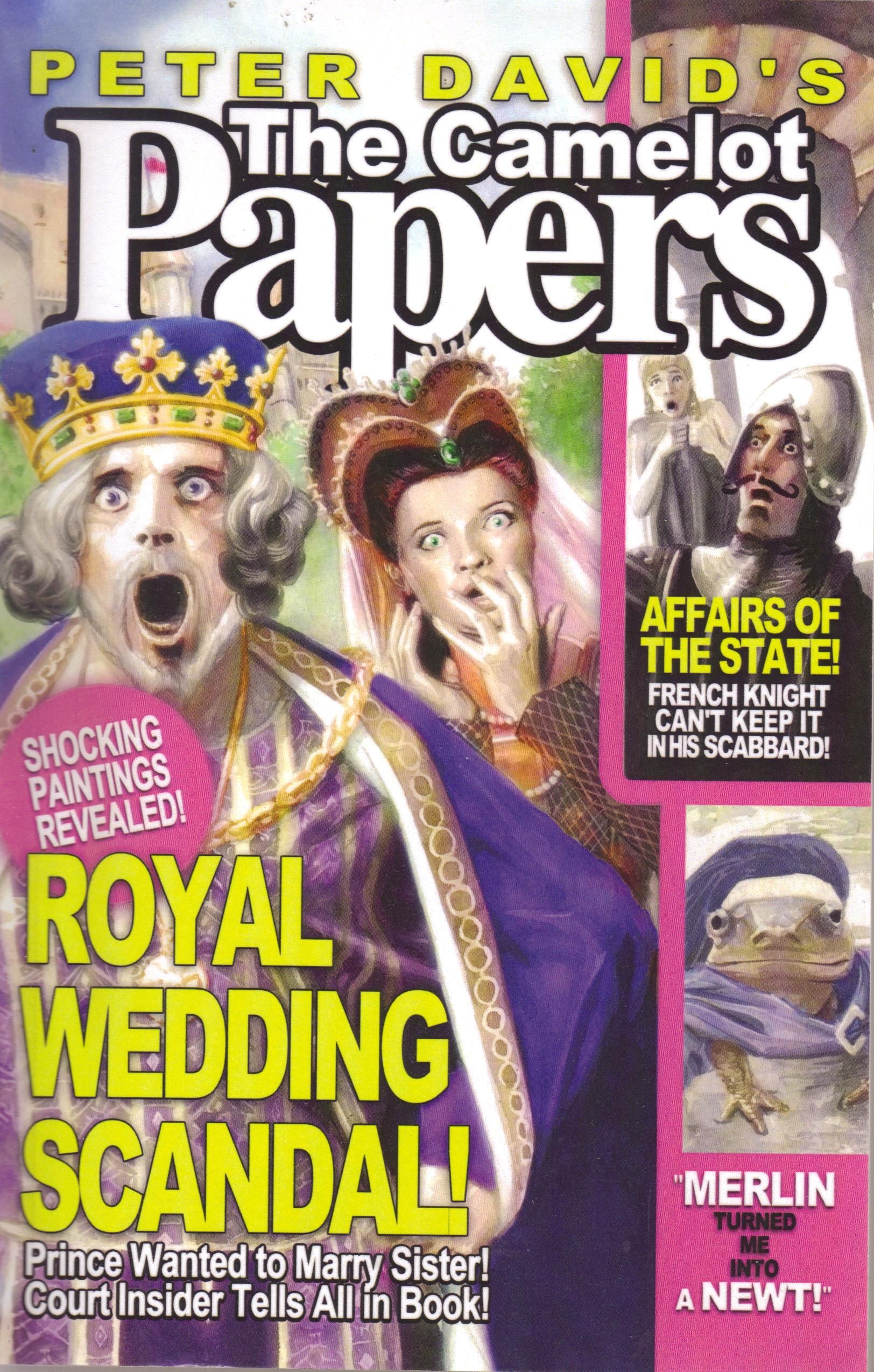"In war we're tough and able / Quite indefatigable / Between our quests we sequin vests and impersonate Clark Gable"
Dial H volume 2: Exchange by Carlo Berrocal (artist), Riccardo Burchielli (artist), Carmen Carnero (artist), Eva de la Cruz (colorist), Taylor Esposito (letterer), Michelle Farran (artist), Dan Green (artist), Tanya and Richard Horie (colorists), Frazer Irving (artist/colorist), Jock (artist), David Lapham (artist), Jeff Lemire (artist), Emi Lenox (artist), Sloane Leong (artist), Tula Lotay (artist), Brendan McCarthy (artist), China Miéville (writer), Allen Passalaqua (colorist), Alberto Ponticelli (artist), Emma Ríos (artist), Mateus Santolouco (artist), Liam Sharp (artist), Zak Smith (artist/colorist), Steve Wands (letterer), Kelsey Wroten (artist), Annie Wu (artist/colorist), Marley Zarcone (artist), and Rachel Pinnelas (editor). $16.99, 218 pgs, FC, DC. Dial H for Hero created by Jim Mooney and Dave Wood.
The second volume of Dial H is a bit weaker than the first, probably because Miéville had to speed up his story a bit before the inevitable cancellation hammer dropped. Nelson and Roxie, who are now sharing their dial, are searching for others in the world, while the new villain - the Centipede - is trying to find them and stop them. It all leads to a battle on an alien world for the fate of the universe, which, you know, isn't surprising.
It's too bad Dial H didn't sell better, because it's probably the best of the DCnU, at least in terms of sheer inventiveness and taking advantage of the medium. Miéville continues to come up with the wackiest heroes imaginable, and a lot of the humor in the book comes from the fact that Nelson and Roxie never know what kind of hero they're going to dial up and whether they can use that particular hero. Miéville also expands the notion of the dial, so there are different kinds of dials for different kinds of experiences - some allow you to teleport, some allow to copy others' powers - and it's impressive to see how he can make it all work. The Operator and the Exchange are creepy in only the way olde-tymey telephones are, and the Centipede is a great sympathetic villain. The revelations about where Nelson and Roxie get their powers is very clever, allowing Miéville to tie things into the greater DCnU without having a guest star. Issue #13, in which Open-Window Man interacts with a chalk drawing, is brilliant, as Miéville makes some more connections with the DCnU but with a nice twist on origin stories. The main story ends rather suddenly, though, and the coda, which appeared in Justice League #23.3 and featured a different artist on each page, is a clever conceit but also ends rather weirdly, as if Miéville wanted to do it as a one-off in the middle of the bigger story but the book got cancelled out from under him. Despite the rushed feeling - there's a particularly emotionally powerful moment that Miéville never really explores, and one wonders if he would have - it's still a marvelously weird comic, which is never a bad thing.
Ponticelli draws most of the comic - David Lapham draws the first issue, but Ponticelli the rest until, of course, JL #23.3. His style is not quite as weird as Mateus Santolouco, who drew the first main arc, but he does have a good, quirky style that makes his wide variety of heroes look goofy, but his solid lines and Green's thick inking also make them look more solid and grounded, so they seem to fit well into the grimy world into which Miéville drops them. One problem with the art is that because there's so much going on, it often seems that Ponticelli forgot some details. Occasionally characters show up in panels where they were nowhere to be seen in the previous one, and it seems obvious they were supposed to be. The book is very busy, and I don't know if Miéville wrote this full script, but if he did, the script is a bit crowded. With so many crazy things happening, it just adds to the feeling of rushed-ness that we get from the book.
Still, DC allowed Miéville to finish his story, and it's a pretty cool one. There are hints about where Miéville might have gone with the book, but it does stand fairly nicely on its own. It's too bad it didn't last, but the 17 issues we did get are pretty neat.
Rating: ★ ★ ★ ★ ★ ★ ★ ☆ ☆ ☆
The Flash volume 2: Rogues Revolution by Wes Abbott (letterer), Oclair Albert (artist), Michael Atiyeh (colorist), Pat Brosseau (letterer), Brian Buccellato (writer/colorist), Wes Craig (artist), Ian Herring (colorist), Hi-Fi (colorist), Scott Kolins (artist), Francis Manapul (writer/artist), Carlos M. Mangual (letterer), Ray McCarthy (artist), Diógenes Neves (artist), Dezi Sienty (letterer), Marcio Takara (artist), Marcus To (artist), Robin Wildman (assistant editor), and Peter Hamboussi (editor). $16.99, 138 pgs, FC, DC. Barry Allen created by Robert Kanigher, John Broome, and Carmine Infantino. Gorilla Grodd, Captain Cold, Weather Wizard, and Mirror Master created by John Broome and Carmine Infantino. Heat Wave created by John Broome. Golden Glider created by Cary Bates and Irv Novick.
The second volume of The Flash points out the problems with the DC reboot quite well. The first volume, like a lot of the DCnU, began after Barry Allen had been the Flash for some years, but it wasn't too big of a deal, as he learned some new things about himself that he might not have thought of during those years. However, in the second volume, Buccalleto and Manapul follow up on a subplot from the first volume involving the "Rogues" - the Flash's villains, and it doesn't work as well. The problem is, of course, that these villains don't have the history of the pre-reboot villains, so what happens to them doesn't have as much impact. Manapul and Buccellato take us through a lot of backstory that's supposed to have emotional resonance to explain why the Rogues are acting the way they do, but because there's no accretion of Rogues behavior over the course of years, it doesn't land as well as they'd like. So Captain Cold's machinations don't feel like betrayals no matter which way he goes, because his relationships with those he's betraying aren't well established. Without that, the story is a simple villain scheme with the requisite twists and turns. It feels like the writers were going for something more epic, though, with the Rogues suddenly acting wildly different than they've acted in the past. When that past doesn't exist because of the reboot, it doesn't work.
The rest of the book feels a bit rushed, as well. Barry ends up fighting Gorilla Grodd for an issue, and while he learns some things about his place in the universe, he quickly moves on from it (I know the gorillas show up again in volume 3, so I'm willing to forgive it). Patty Spivot's investigation into a murder begins (in volume 1) and ends very suddenly, with a fairly dull resolution (it ties into the main story, but it's still very quickly disposed of). The worst thing is the volte-face of Doctor Elias, who in volume 1 was helping out the Flash and at the end of the first issue of this volume is leading a campaign against him (and is actually setting up a bonfire in the middle of the street, which seems would be illegal and at the very least lead the police to believe he's a bit nuts). It makes no sense, even though Elias explains himself to the Flash. Barry Allen decides to "stay dead" instead of telling Patty that he's the Flash, which is also never a good idea. Finally, Buccellato and Manapul don't even acknowledge that Iris West and some innocent bystanders are trapped in another dimension. I mean, Barry could think about helping them at some point, couldn't he?
So, yeah. There's a lot wrong with the writing in this volume. It's not terribly written - it's exciting, and the way the Rogues go about their business is entertaining and the way the Flash fights them is interesting. I imagine, given the way the writers of DC books these days are obsessed with 18-issue story arcs, that this will fit better into the bigger whole, but that's not a terribly good excuse. The dialogue is pretty good, and Manapul and Buccellato keep the reader engaged in the story. It's just kind of odd that so many threads are dangling there.
Even though Manapul doesn't draw the entire book, the fill-in artists do a good job. To has turned into a good superhero artist, so his pages work quite nicely even though they're not as well laid out and flashy as Manapul's work. Manapul breaks down the annual, so the layouts are still in line with the rest of the book, and the artists - To, Albert, Kolins, Neves, Takara, and Craig - are all crisp pencillers whose work fits well with the overall tone of the book. It certainly helps when you have consistent colorists, and while I don't know how much of the book Buccellato did and how much the other colorists did, having a solid colorist set the color tone for the book helps almost as much as having a solid penciller set the artistic tone. So the book looks very good, and it doesn't have that digitized sheen that a lot of DC books have these days. That's always nice.
This volume isn't as good as the first volume, but I still have hopes for the third one. I imagine we'll get two more of the Buccellato/Manapul run, and I'm curious to see how they pull it all together.
Rating: ★ ★ ★ ★ ★ ★ ½ ☆ ☆ ☆
Mr. Peabody and Sherman by Jeremy Colwell (colorist), Sholly Fisch (writer), Tom B. Long (letterer), Jorge Monlongo (artist/colorist), Justin Eisinger (editor), and Alonzo Simon (editor). $17.99, 90 pgs, FC, IDW. Mr. Peabody and Sherman created by Ted Key.
There's not much to say about this trade paperback - it's pretty much like the television show, with hijinks and absolutely horrible puns. Occasionally Fisch takes too long to get to a bad pun, but on the whole, it zips along nicely, helped by Monlongo's wonderfully cartoony art, which is far nicer than the animation on the show ever was (not hard to do, of course, but still). A comic book might be the perfect medium for Mr. Peabody and Sherman, in fact. The art can be stronger than the cheap animation of the show, which is truly terrible, and because Monlongo and Colwell can use a wider palette, the book looks vibrant and fun. Meanwhile, the movie might be good, but I imagine they've forced a longer story on it, which goes against the grain of the cartoon, with its short, silly adventures punctuated by Mr. Peabody's pithy puns. That's more acceptable in comics, as this book zips all over the place and Fisch doesn't really concern himself with a longer plot. Plus, the fact that the movie stars people like Ty Burrell, Stephen Colbert, Stephen Tobolowsky, Allison Janney, Dennis Haysbert, and Leslie Mann means that audiences might be more interested in hearing those voices than they are about hearing the terrible humor. Comic timing, with pauses and reaction shots, are the only advantage the movies have over comics for this kind of story. But I might be biased.
This is a fun trade, though, although it's as light as air. If you have kids, it's definitely a good book to get them - my 8-year-old looked at it and asked if she could read it before I could even crack it open. So it's got that going for it!
Rating: ★ ★ ★ ★ ★ ★ ☆ ☆ ☆ ☆
The Bojeffries Saga by Beardo the Cranky Northerner (writer) and Steve Parkhouse (artist). $14.95, 95 pgs, BW, Top Shelf.
I had never read any of the Bojeffries stories before now, but I knew about them, of course. Most of these were written in the 1980s, when Moore was just on the cusp of American stardom, and while they're not great Moore stories, merely good Moore stories are a lot better than a lot of what's out there, so this is an interesting read. The best story is by far the first one, a two-parter in which Trevor Inchmale tries to collect rent on the Bojeffries home, as he discovered no one had paid rent on it in over a century. This story is far more wryly humorous than the later ones, in which Moore becomes a bit broader, but it's better because the Bojeffries characters are seen from the outside. The family is very Addams Family-ish, with a vampire uncle, a werewolf uncle, a brilliant and ugly daughter who believes she's utterly beautiful, and a baby that seems to be nuclear, but when Inchmale shows up, the fact that he's seeing this all and processing it rather well makes the story very funny. He's so focused on the rent he doesn't really care what kind of strange things are happening around him. Later stories are funny - make no mistake about that - but because they feature the family as main characters, they don't seem to be as clever. The story in which Uncle Festus, the vampire, tries to wander around town is quite funny, and the final one, in which the son, Reth, has escaped the family years later only to be sucked back in is somewhat poignant. None of the stories are bad, because it's Moore, but some are just kind of there. Moore's fascination with light opera is in evidence, as one short story is written like a libretto, which - to me - is the worst kind of Moore story, because it's totally self-indulgent and, more importantly, singing doesn't work in comics. Moore is also, of course, obsessed with Cthulhu, which is never not annoying, but the parodic grandfather in the book is quite funny. Moore's satire is often dated and occasionally very insular, but that's not too big a deal.
Parkhouse is brilliant on the book. His characters look like lower-middle-class paragons, from Jobremus's tired slouch to Raoul's louche disco attire. Inchmale is literally buttoned-up, but his giant glasses and chimney brush mustache show his mousy yet tenacious nature. Parkhouse's style in these stories would look good in Mad magazine or some other satirical publication - he needs to pack a lot onto each page, and Moore's scripts require a lot of work with body language, which Parkhouse does well here. His fairly understated way of drawing the outlandish stuff that occurs in the comic helps Moore's scripts feel more biting, which is not a bad thing at all. The Bojeffries are just another unhappy family struggling through tough times, whose members happen to be literal monsters, and Parkhouse illustrates this weirdness with the right touch of gritty realism to make it work.
If you're a Moore fan, this collection will probably appeal to you. If you're not a Moore fan, you should probably check out his more impressive output. This is a minor Moore comic, but it's still fun to read.
Rating: ★ ★ ★ ★ ★ ★ ★ ☆ ☆ ☆
Prophet volume 3: Empire by Joseph Bergin III (colorist), Ed Brisson (letterer), Brandon Graham (writer), Giannis Milonogiannis (writer/artist/colorist), Jessica Pollard (color flatterer), Simon Roy (writer/artist/colorist), Matt Sheean (artist), Malachi Ward (artist), and Eric Stephenson (editor). $14.99, 131 pgs, FC, Image. Prophet created by Rob Liefeld.
Prophet continues to be a weird-ass comic, although Graham is fashioning it into a fairly standard war story, as the Earth Empire rises again but other clones begin to oppose it. I don't have any problem with that, though - if you're going to tell a story that turns into a plot we've seen before, if you do it like Graham has done, it's far better than just jumping right into it. This is what I mean when I write about trying to do something different with plots - Graham doesn't have a fascinating plot, but he's taken his time creating this bizarre universe, making the characters weird and wonderful, and then slowly moving them into place so that when the plot takes shape, it feels more organic. Some writers don't understand that - they think their plots are so fascinating that they can stand on their own, but most plots aren't like that, because there are only so many plots. Graham, however, has circled around this so much that when it becomes clear what he's doing, the reader is so invested in the strangeness of the universe that it almost doesn't matter that the plot is what it is. I'm rooting for characters on both sides, which is what you want in a complex war comic - who's right and who's wrong in this comic? We want to believe the underdogs are right, but are they? It's something to ponder, I tells ya!
As usual, Graham's artistic collaborators are fantastic - Roy's more detailed work is excellent for the "main" story, while Milonogiannis drops in for his starker, bleaker, and somewhat fiercer artwork to show the movements of the smaller, rebellious group. Of course, all the artists get to draw the bizarre creatures that flit through the book, and the book remains a staggering work of imaginative genius - Graham and his collaborators have created a wonderfully complex universe, and it's fun to watch the characters move through it.
I guess the final issue of Prophet is #45, although I don't know if that's come out yet. Graham has plans for a six-issue mini-series to wrap things up, which makes no sense of me (why not just continue the series?), but I guess that means there are two more trades of this series coming out. I can't wait - Prophet is such a cool-ass comic, and I look forward to seeing what's going to happen.
Rating: ★ ★ ★ ★ ★ ★ ★ ★ ☆ ☆
Lobster Johnson volume 3: Satan Smells a Rat by John Arcudi (writer), Sebastián Fiumara (artist), Mike Mignola (writer), Kevin Nowlan (artist/colorist/letterer), Joe Querio (artist), Clem Robins (letterer), Dave Stewart (colorist), Wilfredo Torres (artist), Tonci Zonjic (artist), Daniel Chabon (associate editor), and Scott Allie (editor). $18.99, 118 pgs, FC, Dark Horse.
The latest Lobster Johnson trade is a hodgepodge of shorter works, which is still kind of neat. I like that when we first were introduced to him, the character was dead, so that Mignola and Arcudi don't really need to move him beyond his 1930s pulp roots. It makes the stories more focused, as there's no possibility he's going to continue on into later decades. This trade features a bunch of nifty stories, all with good artists working on them. "Caput Mortuum" is about a Nazi plot to introduce a toxic gas into New York, which Lobster foils as he fights them on a blimp (because of course he does - it was the 1930s!). Zonjic draws it with his sturdy, no-frills pencil work, which fits the relative "normalcy" of the plot. "Satan Smells a Rat" is a cleverly constructed quasi-Frankenstein story, in which a man is seemingly tormented by zombies, but it's an elaborate ruse to figure out his connection to a crime. It's beautifully illustrated by Kevin Nowlan, who's a good choice for a weird "monster" story. "Tony Masso's Finest Hour" is a clever little tale in which a gangster sells his soul but doesn't think about the fine print, with Querio's rough pencils fitting in very nicely with the creepiness of the story. Fiumara's beautiful rough lines and gorgeous shading make the back alleys of New York come to vivid life in "A Scent of Lotus," and the weird story features angry monkeys, which makes it the creepiest in the collection. "The Prayer of Neferu" is an odd ghost story, and Torres's slightly cartoony style makes the inevitable spooky section a bit stranger. It's a nice cross-section of styles, with Stewart providing a very nice steadying influence with his browns and grays that turn New York into an off-color film reel (except for Nowlan's story, which he colors himself - that's a bit brighter). The stories are interesting, too - Mignola and Arcudi hit a lot of the stereotypical 1930s kinds of stories, but they're good enough that the small twists they put in the stories make them work.
The Lobster Johnson stories, like those of Edward Grey, Witchfinder, are minor additions to the Hellboy Universe, but they're usually solid stories. This trade is certainly no exception!
Rating: ★ ★ ★ ★ ★ ★ ½ ☆ ☆ ☆
Federal Bureau of Physics volume 1: The Paradigm Shift by Jared K. Fletcher (letterer), Simon Oliver (writer), Rico Renzi (colorist), Robbi Rodriguez (artist), Steve Wands (letterer), and Robin Wildman (editor). $9.99, 141 pgs, FC, DC/Vertigo.
FBP is probably most famous for being named Collider before DC realized that some other comic was named Collider, so DC changed the name after the first issue came out. I wonder how much issue #1 is worth?
Anyway, despite now having a crappy name (yes, it totally is), Federal Bureau of Physics turns out to be a pretty cool comic. Basically, the laws of physics are breaking down, and so there's now a government bureau to deal with all the weird stuff that's going on. In the first arc, a bubble universe hives off from our dimension, trapping some people inside, so agents have to go in and retrieve them before the bubble bursts, which will kill everyone inside it. There's also a story about someone using a wormhole for nefarious purposes. And there's a quantum tornado. Why not?
Oliver cleverly doesn't make the book too much about the weird science of it all. Yes, it's fun, but ultimately, the book works because he does some nice work with the characters. The lead character, Adam Hardy, is a typical rogue who plays by his own rules, and he has the typical dark past with the broken home, but Oliver does a nice job making him both likable - he might be a rogue, but he's not a dick - and extremely competent at his job, so when he needs to work, he does. He's also matched well with his partner, Jay, who's a bit older and a bit more responsible, and his boss, Cicero, who early on seems to be the stereotypical uptight asshole but turns out to be just a different kind of agent. After the first arc, a new agent, Rosa Reyes, comes on board, and she's also an interesting character - I guess she has Asperger's, and she also had a very unusual childhood, which is rather intriguing. Oliver puts these characters in tough situations, but except for the weird science, they're very "normal" situations - a rescue mission goes wrong, a man is tempted by money, a fugitive would rather die than face the music, a hostage is taken to ensure cooperation. Oliver can also use this book to examine the privatization of essential functions, as the bureau comes under attack by entrepreneurs who want people to have a choice on who to call for their weird physics problems. It's an interesting and important debate in the real world, and Oliver manages to fit it into this book while still making it wacky enough for a comic. It's a nice blend.
Rodriguez is fine on the comic - his Nathan Fox-lite style (made worse by the fact that Fox does the covers) doesn't blow me away, as he's a bit too sketchy in a lot of the book, but he does a good job with the designs of the characters and the "special effects" of the out-of-control physics. Occasionally there are lapses in storytelling where it becomes difficult to figure out what's going on, and in a comic in which the physical world is acting wonky, the storytelling has to be perfect. Renzi does a very nice job coloring it, with bright pops of color in an occasional dirty world, making them stand out even more, and either he or Rodriguez - I doubt if it's Fletcher or Wands - do some really nice things with sound effects, turning a lot of the noises in the book almost into physical objects intruding on the characters' actions. It's quite neat to see.
So this is a nifty comic. It has an interesting hook, good characters, and nice art. How nice!
Rating: ★ ★ ★ ★ ★ ★ ★ ☆ ☆ ☆
Ultimate Comics X-Men by Brian Wood volume 3 by John Lucas (inker), Alvaro Martinez (penciler), Joe Sabino (letterer), Chris Sotomayor (colorist), Brian Wood (writer), Alex Starbuck (assistant editor), Nelson Ribeiro (assistant editor), and Jennifer Grünwald (editor). $17.99, 100 pgs, FC, Marvel.
Wood finishes his Great Mutant War, as Kitty and Jean face off with the fate of all mutants at stake!!!! This is where the plot is lost a bit on this series - I liked Wood's creation of Utopia and the way Kitty and her group made it work, and I don't even mind that Jean is jealous. But Jean's motivation for going to war - she wants to rule all mutants - is so petty and silly, especially because the more she tries to explain it, the less sense it makes, that I'm stunned she got anyone to go along with it. I think Wood knows it's not a great plot, because he wraps this war up far more quickly than you might expect, although Jean is still around to make trouble at the end of the book, if she chooses to (the series ends, of course, so the question is moot). The rivalry seems so dumb, and Jean's manipulation of the media is so clumsy (although, of course, it works for a while), and the resolution is so quick, that I wonder why Wood even got into it. This could have been a far more complex story, but Wood just skims over the surface, so that it's just a big dumb fight. It's disappointing.
Wood's run on the comic started quite well, but it ends limply, and while I have to believe Marvel's decision to ax the book has something to do with it, I also wonder if Wood just couldn't figure out a way to explore these topics without having people punch each other. It came close, but didn't pay off. It's too bad. Such is life, I guess.
Rating: ★ ★ ★ ★ ★ ½ ☆ ☆ ☆ ☆
Archer & Armstrong volume 4: Sect Civil War by David Baron (colorist), Simon Bowland (letterer), ChrisCross (artist), Khari Evans (artist), Allen Passalaqua (colorist), Fred van Lente (writer), and Josh Johns (editor). $14.99, 102 pgs, FC, Valiant. Archer and Armstrong created by Jim Shooter, Bob Layton, and Barry Windsor-Smith.
I can't imagine Valiant is going to keep releasing Archer & Armstrong trades every month, are they? They're 2-for-2 in 2014, though!
As usual, van Lente's fun comic keeps keeping on, with four issues that aren't great, but they're still very entertaining. When last we hung out with our heroes, Archer had abandoned Armstrong after he caught Armstrong doing the nasty with Mary-Maria, whom Archer loves and also considers his "sister" (which isn't as oogy as you might think; they're both adopted so they grew up together, but he still digs her). Archer went off in a snit and began to plot against the various sections of the "Sect" that runs the world, while Armstrong hung out with his new-found brother, Ivar, for an epic pub crawl through time. Eventually, the two get back together and Archer decides to stop the many groups of the Sect from killing each other, but that doesn't go exactly as planned. The two are back together, but Mary-Maria is now an implacable enemy, and they're about to get sucked into the bigger Valiant Universe. I'm not sure how I feel about that, but I'm fairly confident van Lente can navigate it well.
I'm a bit bummed that these trades are only 4 issues, because they're quick to read and they leave you wanting more, but that's a "me" problem, I suppose. Van Lente shows why he's such a good writer - I've often bemoaned the fact that Marvel and DC comics rarely take breaths anymore, but van Lente is good enough to give us an issue in which the plot moves forward AND Armstrong and Ivar drink the best beers in history, and it's that kind of fun that helps make the Sect Civil War not as horrible as it might be. Plus, van Lente and Evans give us a hilarious two pages where they show all the permutations of the Sect, and one panel in particular is brilliant. There's quite a bit of bloodshed in this trade - more, I think, than in the others, although don't quote me on that - but because van Lente has done such a good job with his two main characters, Armstrong helps break the tension and Archer remains noble even when he's trying not to be. So there's quite a lot of moving parts in this trade, but van Lente is a good plotter, so it's clear he knows exactly what he's doing.
I'd love to write more about the art, but it's a bit weird. Evans draws the first issue, and he reins in his curvy, surreal style a little without sacrificing too much of his individuality. Both Evans and ChrisCross are credited for the rest of the issues, but I have no idea who does what. Either Evans or ChrisCross was able to adapt their styles enough so that it all looks very similar - there are a few panels where I thought I could tell, but not many. Like most of the Valiant books I've read, the art is mainly functional - they change artists a lot, and they always get artists whose styles are similar and fairly generic, at least to a degree. Evans is the most idiosyncratic artist they've had on this series, and even his art doesn't look like his oddest and most interesting stuff (I say this as someone who absolutely love Emanuela Lupacchino's art, but she doesn't challenge the form too much, just draws beautifully in a fairly generic superheroic style). So the art looks good, there are a few clever touches (the pictograms of Armstrong getting drunker, for instance), and David Baron colors it all with a lot of blues and earth tones. It's a slick comic, visually, and that's fine, I guess. It makes writing about the art less interesting, though.
Still, I dig Archer & Armstrong. It's a fun comic. I hope van Lente makes it through the Valiant crossover unscathed!
Rating: ★ ★ ★ ★ ★ ★ ★ ☆ ☆ ☆
Uncanny volume 1: A Season of Hungry Ghosts by Simon Bowland (letterer), Aaron Campbell (artist), Bill Crabtree (colorist), Andy Diggle (writer), and Joseph Rybrandt (editor). $19.99, 132 pgs, FC, Dynamite.
Newsarama tells me on the cover of this: "You won't be disappointed." Well, I guess it depends on what you're expecting, isn't it? Diggle writes good espionage-type stories, and this is an espionage-type story, so on one level, it's perfectly entertaining. But it's disappointing because I kept wondering why Diggle would write this. I mean, I get that writers - too many, in my view - find their niche and never go out of it, but in some ways, it seems like Diggle is sleepwriting through this. It hits all the right notes, it's twisty when it needs to be, the two main characters have some charisma ... but it feels more inert than it should. It's a weird comic, because I don't have anything bad to say about it - Diggle doesn't screw anything too drastic up - but I don't have a lot good to say about it either. Diggle's main character, Dominic Weaver (which isn't his real name, but I guess it's as good as any name), has a power that allows him to absorb the abilities and "read" any he touches, for a limited time. So he's Rogue, except it appears he has control over it, so he doesn't spend decades moaning about it while pining away for shitty Cajuns. In the beginning of the story, he's in a bit of a pickle over gambling debts, but he's rescued by Maggie Ford, a hot Asian woman who works for a mysterious dude interested in hiring Weaver for a job. Apparently, there's a sinister cabal (of course!) that wants to find people with special powers and weaponize them, and the dude - Deacon Styles, another name that exists only in fiction - wants Weaver and Maggie to stop them by hijacking the scientist who's figured out how to do it. That goes pear-shaped, of course, and the two of them need to escape from a facility where they're being experimented on. And there are all sorts of betrayals, because that's how these stories go!
It's not a complete story, unfortunately, because this is an ongoing, so Diggle lays the groundwork for the rest of the series even as he's blowing shit up. As I noted, it's certainly not bad. Weaver is a fairly decent character because he acts like a slick con man, but he's not as good as he thinks he is. Maggie is the typical mysterious secondary character who might be evil but might not, who might be a love interest but might not, but she's more competent than Weaver in fighting and she's at least equal to him. We can see the betrayals coming a mile away, which is annoying, but that's what happens when you get into a niche - you're bound by the clichés of the genre, and Diggle might be good at writing these kinds of stories, but he's not transcending the genre, either. So it's frustrating to read even though it's not terrible.
I do like Campbell's artwork, though. He's getting better and better every time I see his art, and he does a nice job with black smudges and thick, smeared lines in this book to give everything a seedy, desperate look. He appears to be drawing more backgrounds, unless he's still Photoshopping them in but integrating them better in the inking process - either way, his art seems more organic and complete. A few years ago, his backgrounds seemed less a part of the artwork, but it's much better now. He's gotten better with action, too - his figure work is more fluid, and the figures relate to each other better in the action, and it seems like he's doing more thin inking with the characters, which helps make his facial expressions more subtle. Campbell is an interesting artist, and he makes the book visually neat.
I don't love Uncanny, but I don't hate it, either. I want it to be better, and I hope that Diggle is good enough to make it better. I might give it one more trade to see, but we shall see, won't we?
Rating: ★ ★ ★ ★ ★ ★ ☆ ☆ ☆ ☆
The Camelot Papers by Peter David. 427 pgs, Crazy 8 Press, 2011.
I had never read any of David's novels, so when I saw him last year at the Phoenix Comic-Con, I bought this book to see what's what. David writes with the same kind of breeziness he brings to his comics - the book is very easy to zip through, and it's entertaining throughout. I don't like J. K. Woodward's cover, even though it's not a bad painting, because it makes the book seem far funnier than it really is. I mean, there's a Monty Python image right on the cover, and that sets the wrong tone, as the book does tell the "behind the scenes" story of Camelot, but it's fairly serious. So the cover image is kind of strange.
David claims the novel is based on the journal of Viviana, one of the characters in the Arthurian legends. She is usually considered to be the Lady of the Lake, but in David's hands, she becomes a young woman who was sold into slavery by her father and who eventually winds up in Uther Pendragon and then Arthur's court. She's an anomoly at court - she's literate, for one thing, and she's very smart, and she keeps track of what's going on at court, providing the narrative for the story. Of course David upends our beliefs about the Arthurian legends - this kind of thing has been going on for years - but that doesn't mean it's not entertaining. So Arthur becomes a man-child who was never allowed to do much by his overbearing father, Morgan becomes a conniving woman who plans to marry Arthur even though she finds out that Arthur is her half-brother, Guinevere, Morgan's sister, becomes a mannish young woman who is forced to marry Arthur and must figure out how to act more like a woman, Lancelot is a drunk who is mortally terrified of blood (which doesn't diminish his prowess with a sword one bit, but does make him a bit less useful in battle), and Galahad becomes a fiction that Viviana writes about to escape her miserable existence. David does a nice job changing the characters enough so the book becomes interesting but not so much that they're unrecognizable. Viviana, as a slave, is in a perfect spot to observe everything, because, as she puts it, no one pays attention to slaves and speaks freely in front of them. So she's there as the great events of the kingdom play out.
The book is lively and exciting, as Viviana gets caught up in the power politics of the day. David writes cleverly, without the painful puns that his comics are often littered with, and he brings the characters to life very naturally. He falls into cliché a few times, especially when describing Viviana's sexual awakening, which is embarrassing to read. I hate reading descriptions of female sexual awakenings by men, because they seem so ridiculous, even if they are accurate (and I suspect they're not). But overall, he keeps things moving along, with some nice plot twists that aren't too obvious even though they're not exactly all that surprising. David has clear command over the entire plot, which is always nice to see. He ends the book long before Camelot begins to fall, which is somewhat surprising. I suppose he didn't want to clash too much with the somewhat light tone of the book - yes, bad things happen in the book, but it's always fairly hopeful, and bringing in the end of Camelot might drag things down too much.
The Camelot Papers is entertaining and a nice quick read. It's not great literature, of course, but it's a nice diversion, and I'm glad it's not as wispy as the cover implies. David puts some meat in it, and it's a nice way to kill some time.
First three paragraphs:
My first sight of the castle filled me with nothing by a deep and abiding anger. I looked upon it and all I could think was that it was populated by pampered creatures that cared only for themselves and stepped on the backs of people like me on their way to achieving their "great and glorious" destinies. Actually, in truth they did not even consider those like me to be "people." We were just things. I was a thing, a possession, no different than a table or a chair, aside from the fact that they likely care more about tables and chairs than for someone like me.
The lash fell heavily across my back as it typically did when I allowed myself to pause even for a heartbeat. The assistant slave master screamed in my ear, "Keep moving! Keep moving, you mindless cow!"
As I did as instructed, I allowed for the thought that the castle itself was somewhat beautiful; far more majestic than any I had ever seen. And I had seen quite a few in my years.
Rating: ★ ★ ★ ★ ★ ★ ½ ☆ ☆ ☆
That's another month in the books! I hope you found something interesting to buy, because we all need to spend more money on comics!

